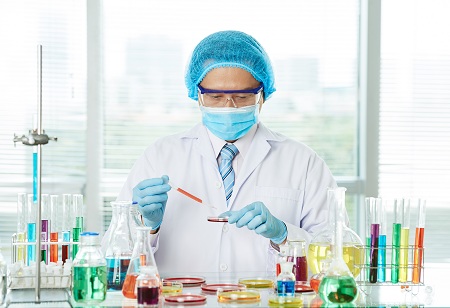Richa Singh | Friday, 13 October 2023

Pharmaceutical testing is essential in the development of new therapeutics since it ensures that medications are safe, effective, and capable of treating a wide range of medical diseases. The pharmaceutical industry's core is this complicated process, which includes preclinical and clinical testing, regulatory assessments, and post-market surveillance. Let's take a look at how pharmaceutical testing affects drug development.
Preclinical Testing: The Foundation of Drug Development Preclinical testing is the first stage of drug development in which possible therapeutic candidates are evaluated rigorously in laboratory and animal experiments. These tests serve as the foundation for subsequent development. The primary goals of preclinical testing are to evaluate a novel drug's safety, pharmacokinetics, and pharmacodynamics. Safety evaluations seek to uncover any potential hazardous consequences, assisting in the early elimination of medication candidates with poor safety profiles. This avoids wasting resources on dangerous substances and protects patient safety. Understanding a drug candidate's pharmacokinetics and pharmacodynamics is critical for identifying proper dosages and efficacy. This phase also aids in the identification of potential mechanisms of action as well as the planning of clinical trials. "The impact of pharmaceutical testing on drug development is transformative. It allows us to translate scientific discoveries into life-saving therapies while adhering to the highest standards of safety and efficacy." Says Dr. William Hait, Global Head of R&D at Janssen Pharmaceuticals.
Clinical Testing: A Multi-Phase Journey When a medication candidate passes preclinical testing, it advances to clinical trials, where its safety and efficacy are assessed in human patients. Clinical testing is divided into phases, each with its own function. Phase I trials usually involve a small number of healthy participants and are primarily concerned with safety and dose. Phase II of the trial includes a larger number of patients and evaluates both safety and preliminary efficacy. Phase III trials, which can involve thousands of individuals, broaden the patient pool and provide a more comprehensive review of a drug's efficacy and safety. These trials assist in determining whether a medicine is superior to existing treatments and offer the data required for regulatory approval. Clinical testing has a significant impact on drug development. It detects probable side effects, fine-tunes dose regimes, and guarantees that medications are efficacious in a wide range of patient populations. Furthermore, it frequently discovers unexpected uses for medications, resulting in increased indications.
Regulatory Assessments: Ensuring Safety and Efficacy Regulatory authorities such as the Food and Drug Administration (FDA) in the United States and the European Medicines Agency (EMA) in Europe play an important part in the pharmaceutical testing process. These organizations examine preclinical and clinical trial data to assess whether a medicine is safe and effective for use in humans. Because regulatory approval is required for market access, their assessments have a significant impact on the drug development process. The significance of regulatory evaluations in drug development cannot be emphasized. To protect public health, strict regulatory scrutiny ensures that only safe and effective medications enter the market. These evaluations necessitate thorough documentation, rigorous testing, and detailed safety profiles, requiring pharmaceutical businesses to maintain the highest standards in their R&D activities. Post-Market Surveillance: The Continual Assessment The testing of pharmaceuticals does not end with regulatory approval. Post-market monitoring is an important part of the drug development process because it monitors the safety and efficacy of medications after they are made available to the public. This monitoring aids in the detection of unusual adverse events that may not have been detected during clinical trials. Adverse events must be reported to regulatory agencies by pharmaceutical companies, and these reports contribute to continuing safety reviews. Patients and healthcare providers can also help with post-market surveillance by reporting any unexpected side effects or difficulties they encounter. The influence of post-market surveillance is critical for ensuring drug safety in the real world and allowing for required regulatory action, such as recalls or label revisions, if safety concerns surface.
Cost and Time: The Dual Challenges of Pharmaceutical Testing Pharmaceutical testing is a time-consuming and expensive endeavour that necessitates a large financial investment. These obstacles have far-reaching consequences, affecting drug prices, access to novel therapies, and the capacity to bring life-saving medications to market. Pharmaceutical testing's cost burden frequently translates into high medicine pricing. The expense of R&D, preclinical and clinical testing, and regulatory compliance all contribute to drug prices, making access a difficult subject. In the pharmaceutical sector, finding a happy medium between recouping development expenses and preserving affordability is a constant problem. Furthermore, the protracted drug development process has ramifications for individuals in need of therapy. Individuals with life-threatening or rare diseases may not have the luxury of waiting years for potentially life-saving treatments because of the time it takes to proceed from preclinical research to regulatory approval. Pharmaceutical testing is a sophisticated and multidimensional procedure that is critical in the development of new drugs. Preclinical and clinical testing, regulatory evaluations, and post-market surveillance guarantee that medications are safe, efficacious, and appropriate for a wide range of patients. The impact of pharmaceutical testing is visible in the quality and safety of pharmaceuticals provided to the public, but it also poses cost and time issues. The pharmaceutical industry's constant goal is to strike a balance between rigorous testing and timely access to breakthrough medications, with patient well-being at its centre. As technological and scientific advances continue to influence the pharmaceutical landscape, the impact of pharmaceutical testing on drug development is an ever-changing and vital component of healthcare.